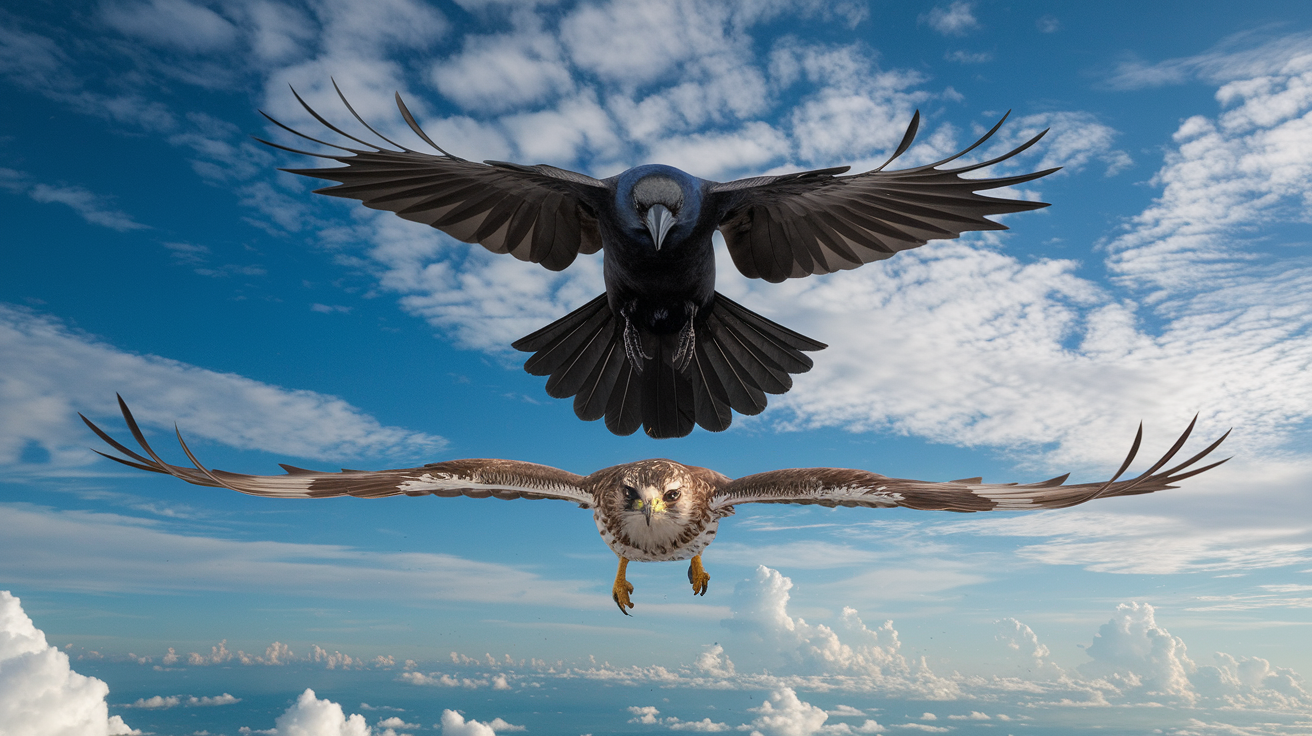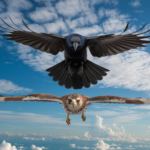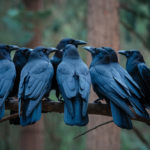Crows are known for their intelligence and social behavior, and one of the most fascinating aspects of their behavior is their tendency to chase away hawks. This action, often referred to as mobbing behavior, plays a crucial role in their survival. By understanding why crows engage in this behavior, we can gain insights into their complex social structures and the natural dynamics of avian life.
Key Takeaways
- Crows engage in mobbing behavior to protect their nests and young from predators like hawks.
- Mobbing is a collective defensive strategy, where birds work together to confuse and deter a predator.
- Territorial defense is crucial for crows, as it ensures access to resources and safety for their offspring.
- Mobbing can serve as a learning experience for younger crows, helping them develop essential defense skills and strengthen social bonds.
When crows see a hawk, they often gather together and chase it away from their territory. This group strategy helps protect their nests, young chicks, and even themselves from potential predation. The act of mobbing showcases not only the crows’ courage but also their ability to work collectively to fend off a bigger threat.
Defining Mobbing Behavior in Birds
Mobbing behavior is a fascinating phenomenon observed in many bird species when they confront predators. Essentially, it involves a group of birds gathering to chase away or harass a threatening bird, like a hawk. This behavior serves as a defensive tactic and can significantly reduce the risk of predation.
Besides crows, numerous bird species exhibit mobbing behavior, including blue jays, sparrows, and various types of songbirds. By banding together, these birds can make themselves look larger and more intimidating, effectively discouraging the predator from remaining in the area.
- Crows
- Blue Jays
- Sparrows
- Songbirds

Explanation of Mobbing Behavior
The main purpose of mobbing is to protect the young and the nest. When a group of birds mob a predator, it can confuse and distract the hawk, making it difficult for the hawk to focus on its target. This is especially crucial during breeding season when young chicks are vulnerable and need protection.
Mobbing can be quite noisy and chaotic, with caws and alarm calls filling the air. The presence of so many birds can create a sense of urgency and alertness, signaling to other birds in the area that there’s danger nearby. This behavior not only protects the immediate group but can also warn other birds of the threat.
Examples of Mobbing in Various Bird Species
Different bird species show unique ways of mobbing. For instance, crows and jays often dive and swoop at the predator, while other birds may simply create a loud chorus of alarm calls. This strategy can vary based on the species and the environment they inhabit.
Here are some examples of mobbing behavior in various birds:
- Crows: Known for their loud caws and coordinated attacks.
- Blue Jays: Often scream loudly and dive toward the predator.
- Titmice: Will gather in groups, flapping their wings and making noise.
Crows vs. Hawks
Territory is crucial in the bird world. For crows, defending their territory is essential not only for their safety but also for ensuring that their young can thrive. When a hawk invades their space, crows react promptly, employing mobbing behavior to assert their dominance.
Understanding territorial dynamics helps us appreciate the complex interactions between different bird species. These interactions are not just about survival; they also play a significant role in maintaining ecological balances within their habitats.
The Importance of Territory in Bird Behavior
Territory serves as a safe space for birds to raise their young and find food. For crows, a well-defined territory means they have access to resources while also keeping predators at bay. When a hawk enters their territory, crows view it as a serious threat that must be addressed immediately.
Territorial disputes are common in the bird world and can lead to intense confrontations. Crows will often work together to chase away hawks, showcasing their strong social bonds and teamwork. This collaboration not only enhances their chances of success but also reinforces their position in the ecosystem.
How Crows Utilize Mobbing as a Defense Strategy
Crows are clever creatures, and they’ve adapted their mobbing behavior as a key defensive strategy. By working together, they can effectively disrupt a hawk’s hunting attempts, making it harder for the predator to target them or their young. This collective action is a smart way for crows to enhance their survival chances.
Moreover, mobbing can serve as a learning opportunity for younger crows. Observing and participating in mobbing not only trains young birds in defense strategies but also strengthens the social structure within the group. This passing of knowledge is essential for the overall success of their species.
Behavior of Crows and Hawks
Understanding the interactions between crows and hawks can be fascinating! These two birds have very different behaviors and roles in their ecosystems. Crows often chase hawks as a way to protect their territory and young ones. This behavior, known as mobbing, shows how smart and social crows can be.
In summary, crows and hawks have a complex relationship that is shaped by their instincts and intelligence. While hawks are skilled hunters, crows use teamwork and strategy to defend themselves. Observing these interactions can give us great insights into their behavior and the roles they play in nature.
Frequently Asked Questions about Crow and Hawk Interactions
Many people are curious about why crows act the way they do around hawks. Here are some common questions and answers that can help clarify these interactions:
- Why do crows attack hawks? Crows attack hawks to protect their nests and young. They also want to defend their territory.
- What is the significance of mobbing behavior? Mobbing helps to drive away potential threats, allowing crows to keep their environment safe.
- Do crows eat hawks? No, crows don’t eat hawks. They will attack them but not for food; it’s more about defense.
- How do different crow species interact with hawks? Different crow species may show varying levels of aggression and teamwork when dealing with hawks.
Join the Birdwatching Community for Insights
If you’re interested in learning more about birds, joining the birdwatching community is a great way to get started! You can share your experiences and learn from others who love birds as much as you do.
- Subscribe for Updates on Bird Behavior: Stay informed about the latest research and behaviors of crows and hawks.
- Wildlife Observation and Birding Gear Recommendations: Get tips on the best gear for birdwatching and where to find birds in your area.
- Share Your Observations and Experiences: Connect with other bird enthusiasts and share the amazing things you’ve seen!
Birdwatching can be an exciting and educational hobby. It allows you to observe these incredible species and better understand their interactions!
Mobbing Behavior in Birds
Percentage of Mobbing Behavior Exhibited by Different Bird Species
Mobbing Behavior Summary
Crows: 60% | Blue Jays: 30% | Sparrows: 20% | Songbirds: 10%







